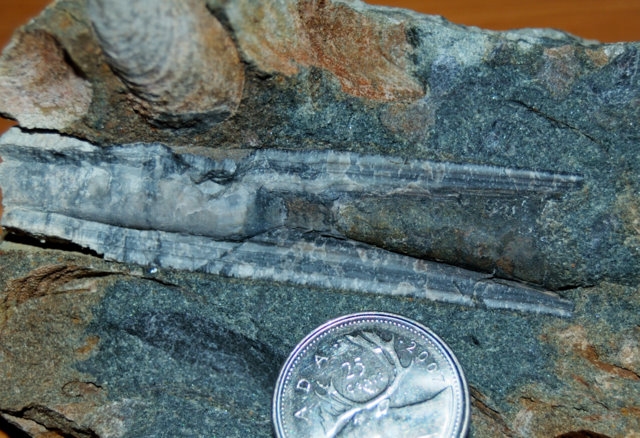Fossilization is an exceptionally rare occurrence, because most
components of formerly-living things tend to decompose relatively
quickly following death. In order for an organism to be fossilized,
the remains normally need to be covered by sediment as soon as
possible.
Belemnites were numerous during the Jurassic and Cretaceous
periods, and their fossils are abundant in Mesozoic marine rocks,
often accompanying their cousins the ammonites. The belemnites
became extinct at the end of the Cretaceous period along with the
ammonites. Well-formed belemnite guards can be found in rocks
dating from the Mississippian (or Early Carboniferous) onward
through the Cretaceous. Normally with fossil belemnites only the
back part of the shell (called the guard or rostrum) is found. The
guard is elongated and bullet-shaped, being cylindrical and either
pointed or rounded at one end. The hollow region at the front of
the guard is termed the alveolus, and this houses a chambered
conical-shaped part of the shell (called the phragmocone).
Below is an image of a fossilized belemnite guard collected from
this site. Notice the scale with regard to the Canadian quarter.
This is one of the larger ones found at this location, most are
considerably smaller. Also note the small clam fossils on the left
side of the image. Check out the other images in the gallery or at
the bottom of the page.

In abundance you will find Buchia (clam) fossils in these
siltstone sedimentary rocks.

The abundance of clams intermixed with the belemnites in
siltstone suggest they originated in a shallow sea. After these
creatures died, they were gradually covered by silt from either a
large river or constant glacial outwash. Over time, the weight of
the silt continually increases, causing the silt particles to bond
together, forming a very tough stone. Although often mistaken as a
shale, siltstone lacks the fissility and laminations which are
typical of shale. If you were to try splitting these rocks, you
would see that they are very unforgiving and do not split nicely
along layers.
Ammonite fossils can also be found in this general area, but not
at this site. The ammonites are found in the bedrock, and require
excavation so I will not highlight their location in this
earthcache.
In order to log this earthcache as a "find" you must email me the
answers to the following questions:
1:) At the secondary location (bridge) it is obvious that the
rocks were brought here as road bed material. At the main location
(where this earthcache is located), what causes you to believe that
these fossils did not originate at this site either?
2:) Check the elevation displayed on your gps. What is the
elevation of the main site? These are marine fossils; how do you
think they came to be located this high?
Optional task:) Please post a photo of any fossils you found,
with your log.